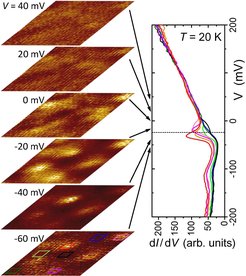Visualizing polaron formation in EuB6
The intricate interplay between structural, magnetic and electronic degrees of freedom in correlated electron materials, especially those that involve rare earths and transition metals, has given rise to unexpected and spectacular physical phenomena such as high temperature superconductivity (HTSC) in cuprates and colossal magnetoresistance (CMR) in magnetic semiconductors and manganites. A ubiquitous characteristic of such complex materials with competing interactions is a rich phase diagram, in which many phases exhibit intrinsic (i.e. electronic, and non-chemical) phase separation. Such an electronic phase separation often results in transitions that are percolative in nature. Nanoscale electronic phase separation is thought to play a critical role in the emergence of HTSC and CMR, as well as in the suppression of critical dynamics in quantum phase transitions. In particular, in the metal oxide compounds, stripe and chequerboard inhomogeneous electronic phases are often linked to HTSC and CMR. Therefore, electronic phase separation has been a subject of intensive recent theoretical and experimental interest.
CMR-like effects based on electronic phase separation are not limited to the mixed-valence perovskites, but are observed also in a number of far simpler compounds, for example, in the Eu chalcogenides. As a general observation, the magnitude of the magnetoresistance near the ferromagnetic Curie temperature TC is determined by the value of TC, i.e., the lower the TC, the larger the magnetoresistance ratio will be. Furthermore, it has long been recognized that the resistivity is directly related to the state of magnetization of the materials. In fact, the observation that the magnetic state of a system critically affects its electronic transport properties is at the heart of spintronics research.
The europium hexaboride system is appealing because it can be prepared in a clean fashion, and because its lattice and magnetic symmetry is high, which simplifies many considerations. Yet, it shows interesting physical properties like CMR and a delocalization transition of charge carriers, which accompanies the ferromagnetic ordering. In recent years, there has been increasing evidence for the crucial role of electronic and magnetic phase separation in explaining the interesting magnetic and transport properties of this material. The details of these processes, however, remain elusive to a large extend, in particular, since there is no direct evidence for percolation from transport measurements. Furthermore, investigations of the dynamical aspects of the electronic phase separation as well as local information with nanometer resolution are still lacking.
It is therefore vital to provide direct evidence for the electronic phase separation in EuB6 as well as to investigate the magnetic cluster formation in finite magnetic fields. In our recent paper, we combined Scanning Tunneling Microscopy/Spectroscopy (STM/S) to visualize electronic inhomogeneities and magnetic stray field studies utilizing ultrasensitive, micrometer-sized Hall bar arrays.
The figure exemplifies an STS study at 20 K. At this temperature, the magnetic polarons, i.e. magnetically ordered clusters, have already formed (their formation commences at around 35 K). Yet, these clusters do not yet percolate and hence, the material is still paramagnetic and exhibits very large resistance. Locally and at certain bias voltages between –40 mV and ~0 mV, however, highly conductive areas of about 3 – 4 nm in size are visible in our STS measurements. These are exactly the electronic inhomogeneities we were looking for. Such inhomogeneities are absent deep in the magnetically ordered phase, i.e well below about 12 K.
Hall bar measurements on exactly the same sample was conducted in the group of Prof. Jens Müller, Goethe-University of Frankfurt. In small magnetic fields, a local magnetic stray field was detected below the magnetized sample, which signified the existence of large magnetic clusters. In larger magnetic fields, a classical mean-field analysis of this more homogeneous magnetization state indicated a cluster size of the order of a few unit cells, in good agreement with our STS results.
SW / CPfS

Figure 1. Left: Locally resolved conductance maps over areas of 20 nm x 20 nm at different bias voltages V and a temperature of 20 K. Specifically at V = –20 mV local electronic inhomogeneities are clearly visible. Right: Area-integrated tunneling spectroscopy curves. The areas are marked by rectangles of corresponding colors in the map obtained at V = –60 mV. Significant electronic inhomogeneities are observed only for V between –40 mV and 0 mV.
